Seoul's restaurants now have Michelin stars. You would assume local Koreans would be excited by this news, by the fact the world's most famous food guide has deigned to review their eateries and reward some with the coveted sparkly gongs. You would think the chefs who receive these stars would now be revered. You would assume those restaurants would be considered the best.
But you might be wrong. Because this, right here, feels more like the real deal. This is the food Koreans truly love.
It's a basic restaurant, this one, a place where milk crates act as spare seats, where the owners' kids do their homework over in the corner of the dining room. Each table that's not covered in essays and maths problems is set up with a circular metal grate in the centre, recesses that have been filled with red-hot oak wood embers.
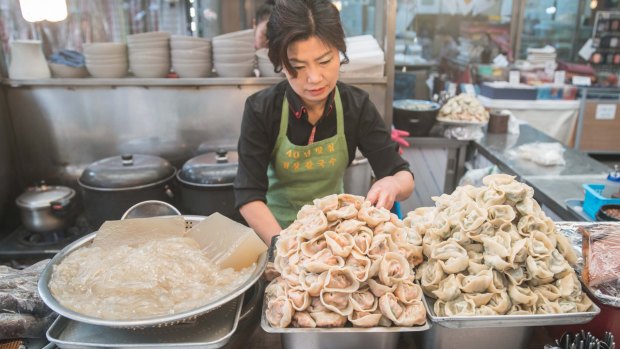
Dumplings. So many dumplings.Credit: Ben McNamara
It's cooking time. The meat we're eating today didn't come from this restaurant – it was sourced from the market down below, where the finest cuts of marbled beef where chosen for our barbecue. This eatery is providing the table, the charcoal, a few pairs of tongs, and the traditional Korean barbecue side dishes of lettuce, garlic, onion, kimchi and gochujang, the ubiquitous fermented chilli paste.
"This is the way Koreans like to eat," says Daniel Gray, a Korean-American food critic and restaurateur who now calls Seoul home. Daniel chose the meat downstairs. He carried it up to this restaurant. In this country where the food can seem a little daunting at first, a little hard to decipher, Daniel is my window into the cuisine.
And it's Daniel who gets the meal started today, laying a few slices of meat on the charcoal grill and tending to them with the tongs as they sizzle away.
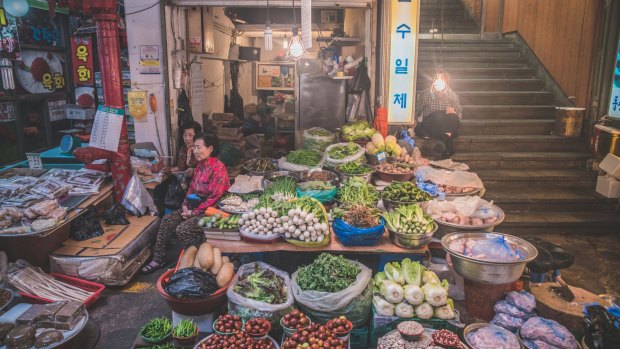
Markets offer fresh produce. Credit: Ben McNamara
This style of eating is perhaps Korea's most famous export, and it's a simple, produce-driven approach to food that we'll find in various forms throughout the country. The fancy stuff is one thing – the Michelin stars, the nouvelle cuisine – but most Koreans seem to prefer simple, unpretentious meals such as this.
They like street food on sticks. They like soup made from bean sprouts. They like fish grilled on coals. They like fried chicken with beer.
Most of their food, in fact, pairs well with beer, and the rice spirit called soju. You realise after a few nights here that Koreans seem to have two main uses for their cuisine: to be consumed as an accompaniment to beer and soju, and to be consumed as a cure for drinking too much beer and soju. It's food to celebrate, and food to recover. I like this place.
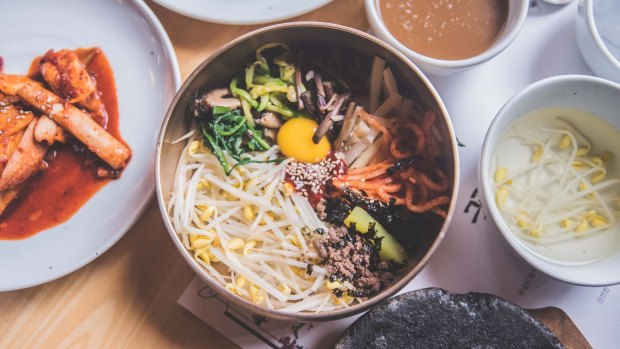
Soup made from bean sprouts.Credit: Ben McNamara
Daniel begins our tour, somewhat perversely, with food for recovery. We meet at Gwangjang Market, a bustling little spot in central Seoul, the sort of place you'd walk past a hundred times without realising that some of the city's best street eats are being dished up inside. We take a short stroll of the stalls as Daniel explains the cuisine this country has to offer.
Is Korean food the world's next big thing? Could it rival Japanese or Italian or Chinese for our affections? It's certainly on its way, with the recognition provided by Michelin, as well as a crop of Korean restaurants appearing in cities around the world. However, you need to be in situ to truly appreciate it.
Most of the vendors at Gwangjang Market have been here for generations, dishing up the simple, delicious offerings that Koreans cherish, and that most people outside the country will never have heard of. There's mayak kimbap, dried seaweed rolls filled with carrot, pickled daikon and rice that are dipped in sesame oil and sugar. There's bindaetteok, or mung bean pancakes, cooked with bacon. There's ganjang-gejang, small crabs that are fermented in soy sauce, heavily salty, seafoody morsels that are an acquired taste.
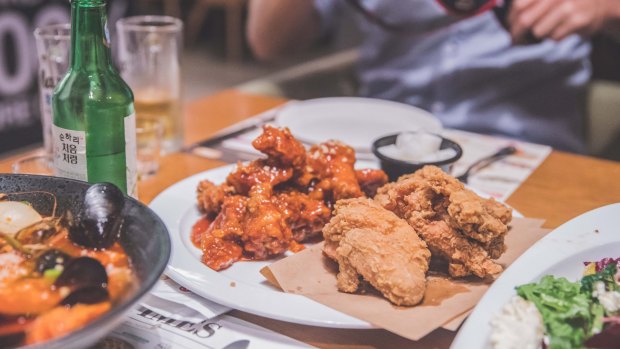
Fried chicken is a Korean favourite.Credit: Ben McNamara
They're indicative, however, of Korean cuisine as a whole: big, bold flavours that work as a counterbalance to the blandness of rice, or the subtlety of Korean beer. Most dishes are salty, sour, and spicy – delicious, and strong.
At Sutbal Taktak, the barbecue restaurant above Majang Meat Market, we're experiencing all of those things once again. We drink beer with shots of soju and eat perfectly cooked beef while Daniel recalls the time he took Anthony Bourdain on a tour of Seoul while he was filming his TV series No Reservations.
And then, we're off again. That was lunch. For dinner we're having chimaek, the Korean staple that's surely coming soon to a pub near you.
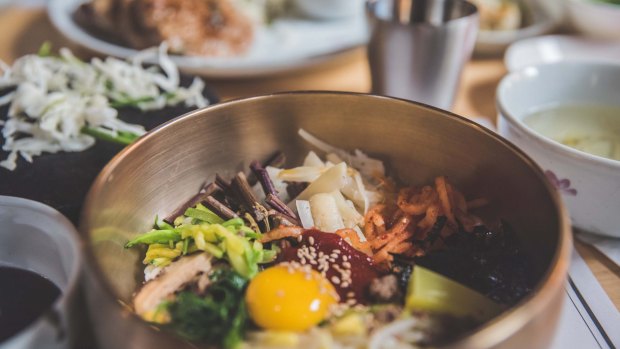
Seoul foodCredit: Ben McNamara
Chimaek is a portmanteau of chicken and maekju, the local word for beer: in other words, two of your favourite things, together at last.
Korean-style fried chicken is a hugely popular staple adapted from the dish introduced by US serviceman during the Korean War. In Korea the chicken pieces are in tossed in salt, sugar and spices before being fried twice, resulting in succulent hunks of bird covered in a shatter-crisp skin. Pair it with beer, and you're in heaven.
Once again, this is not fancy food. It's not eaten in Michelin-starred restaurants, but in bustling, hole-in-the-wall dens that line the streets in suburbs such as Hongdae, Itaewon and Myeongdong. It's simple food, with strong flavours, served with beer. Everything that's good about Korean cuisine.
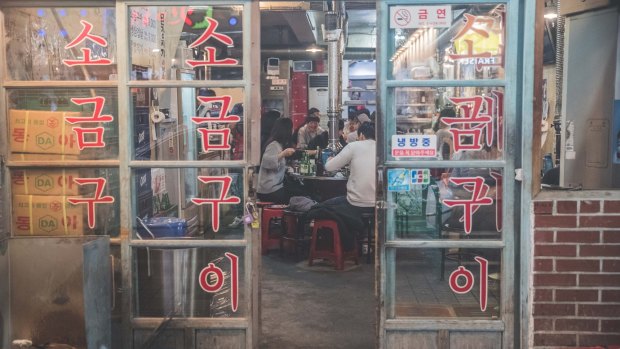
A typical restaurant.Credit: Ben McNamara
But wait, as they say, there's more. Korea's beating heart might be Seoul, but it's growling stomach is Jeonju, a UNESCO City of Gastronomy about two hours south of the capital. Jeonju is a major hub for agriculture, as well as the home of some of the country's best restaurants.
Of course, in Korea that doesn't mean they're fancy. It means they're tiny, unpretentious places that focus as much on alcohol as they do cuisine.
Yetchon Makgeolli is the perfect example, a ratty, nondescript restaurant that has a huge queue outside when we arrive, hoping to grab a table. Fortunately everyone seems to know Daniel so we're waved in and seated in no time.
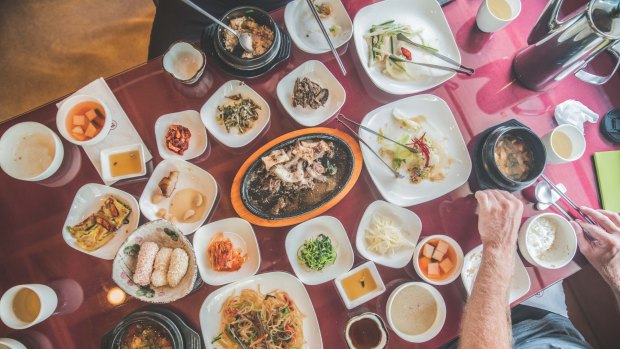
A bit of this and a bit of that.Credit: Ben McNamara
"Here's how this works," Daniel explains. "Mostly, you're here to drink makgeolli. The more makgeolli you order, the more food they bring to the table. The more food they bring, the more interesting it becomes."
The makgeolli is a sweet, milky, boozy rice drink, served in large copper pots. The food is slapped onto our table whenever it's ready: steamed clams, omelettes, hunks of beef, fried fish. So far, so approachable. As the night goes on, however, the makgeolli flows, and the food begins to change.
First we get hongeohoe, a dish of fermented – essentially rotten – fish that has a pungent, ammonic smell that doesn't even go close to being masked by the pork belly and kimchi it's served with. Hongeohoe is challenging, to say the least.
The next dish is similarly confronting: sannakji, or fresh octopus tentacles served in sesame oil. These tentacles arrive at our table so fresh that they're still moving, literally writhing around on the plate, a salad that tosses itself. Daniel casually mentions that it's best to chew these things vigorously, lest they attempt to attach themselves to the inside of your mouth.
That's advice that you tend to take extremely seriously.
And then, in what seems like no time at all, we're suddenly eating breakfast. Recovery time. It's the day after the night before, the wriggling octopus legs are the mere stuff of my future nightmares, and we're queuing up once again at a hole-in-the-wall dive that does some of the city's best food.
This is Hyundai-ok, a 10-seater restaurant that specialises in every Jeonju resident's favourite hangover cure, a bean sprout soup called kongnamul gukbap. As ever, the soup is reminiscent of everything that's great about Korean cuisine: simple, fresh, strong flavours that provide instant recovery from a boozy night, and with a name that's extremely difficult to pronounce.
This place will probably never earn a Michelin star. But no one around here seems too concerned.
TRIP NOTES
MORE
intrepidtravel.com/au/south-korea
FLY
Asiana Airlines has daily direct flights from the east coast of Australia to Seoul. See au.flyasiana.com
STAY
The Lotte City Hotel in Myeongdong, Seoul has spacious rooms with great views from $169 a night. See lottehotel.com
EAT
Intrepid's Real Food Adventure of South Korea, coordinated by Daniel Gray, is an eight-day tour of the country's culinary highlights, starting from $2895 a person, and including accommodation, transport, most meals and activities, and the services of a guide. See website above.
Ben Groundwater travelled as a guest of the Korean Tourism Organisation and Intrepid Travel
FIVE KOREAN DISHES YOU HAVE TO TRY
CHIMAEK
Plenty of restaurants across the country specialise in this combination of two Korean favourites: fried chicken, adapted from the dish introduced by US servicemen, and beer. The chicken is spicy and the beer is cold. What more could you want?
BARBECUE
Another Korean favourite, you'll be able to spot these restaurants by the telltale exhaust fans hanging over every table. Cuts of meat such as pork belly, tongue, and Korean wagyu beef are grilled over charcoal and eaten with lettuce leaves, fresh garlic, and fermented chilli sauce.
KONGNAMUL GUKBAP
The breakfast of champions: this soup made from fresh, wonderfully aromatic bean sprouts is topped up with rice before being devoured by most Koreans as a recovery from the alcoholic excesses of the night before. It's also a fantastically nourishing soup in its own right.
BINDAETTEOK
Mung beans are soaked in water and then ground to a paste to make the base for these delicious fried pancakes, which usually have kimchi and beef, and even hunks of crispy pork belly added before they're cooked in oil and devoured.
MAKGEOLLI
Though soju is probably Korea's most famous alcoholic beverage, makgeolli is a contender for its most popular. Entire bars are dedicated to the consumption of this milky, sweet rice wine, which should always be accompanied by food.
Sign up for the Traveller Deals newsletter
Get exclusive travel deals delivered straight to your inbox. Sign up now.